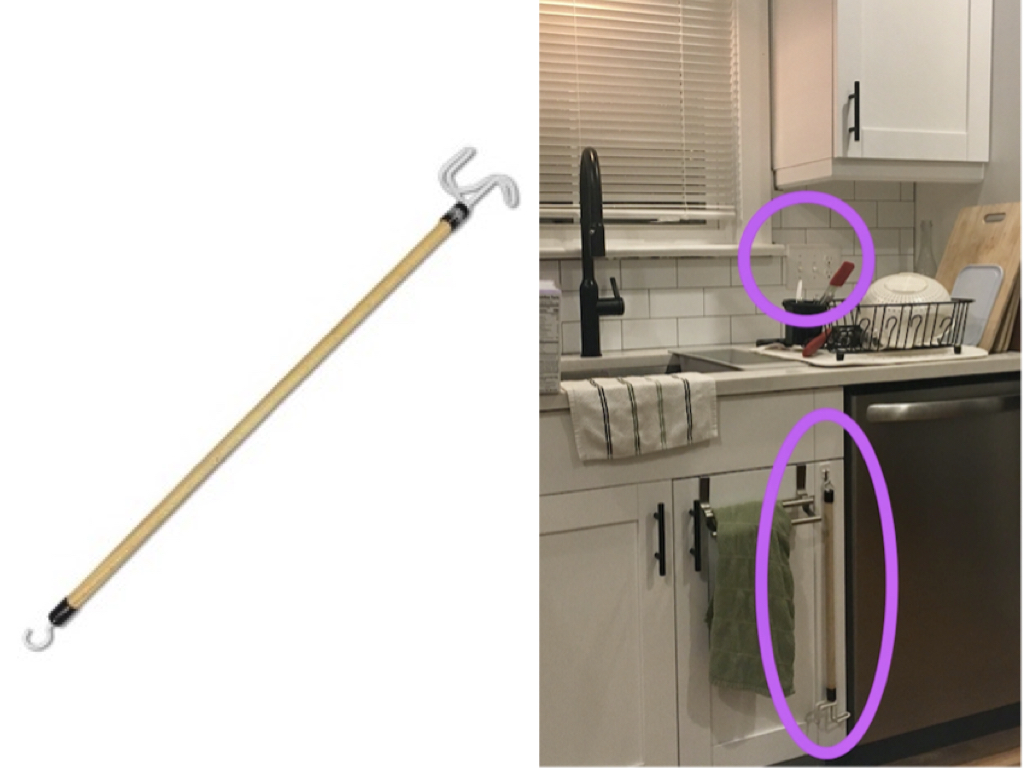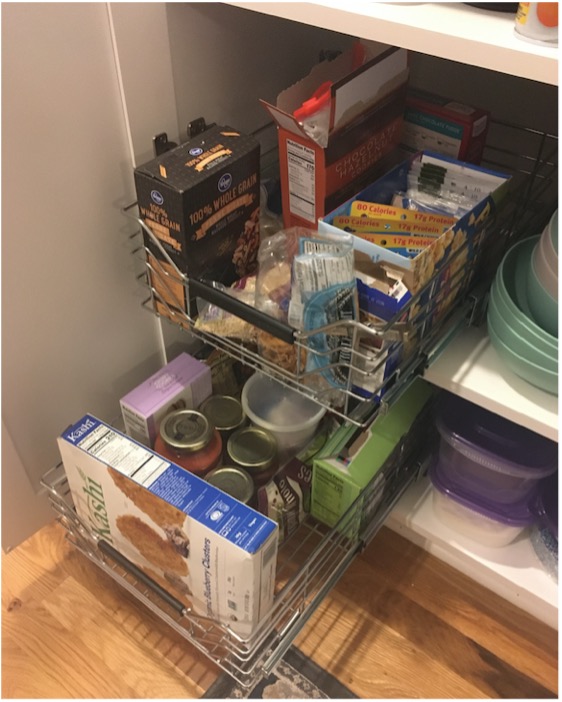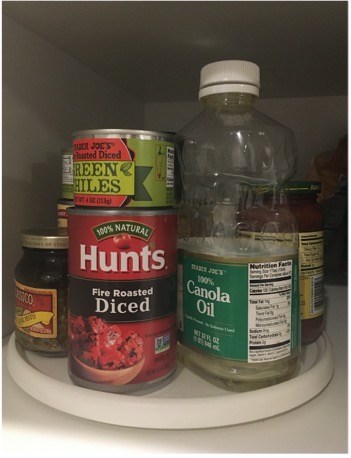Allison’s A-List

As a person who has lived with Morquio for over 3 decades now, I have given a lot of time and thought to what it means to shape my environment to be as accessible and simple as possible, and I imagine many of you have as well. Morquio can be an exhausting condition to live within and of itself, but having to live, learn, and work in environments that are designed for average height people compounds that difficulty. We each carve out ways of living in our homes and communities and make adjustments along the way, but living with a rare disorder means most of us are isolated from other people with that shared experience. I’m hoping this post – and perhaps future posts to come – might serve to bring those experiences a little closer and create a space for sharing creative solutions to some of those challenges.
First, a little about me: I am 35 years old and am originally from Virginia Beach. I moved to Richmond, VA in August 2019 to start a new job and ended up buying my first home at that time – thankfully, just before the pandemic began and the housing market exploded. I have a younger brother John, who is 32 years old and also has Morquio and is now in the process of buying his first home as well. We have both found it very helpful to have another person to problem-solve with around the challenges that come with Morquio through each stage of our lives, and have also found a great deal of strength in each other.
At this time of year, best-of lists abound: best gifts guides, best new tech innovations, best toys, best holiday movies. So consider this post my best-of “life hacks” for living independently with Morquio – small adjustments I have made in my home to shape a space that fits me and makes daily life more simple, in the hopes that some of these ideas will be helpful to others as well. With that…here goes!
Contents
1. Smart lights

Having smart lights in my home has been a game-changer for me. They have made life much much easier – on top of being fun to play around with!
I use the Philips Hue bulbs, although there are plenty on the market to choose from. For me, the White Ambiance options are ideal, because they allow you to dim and change the hue of your lights from bluish white to yellowish white. The full color bulbs provide a lot more to choose from and play around with, if you’re up for something more expensive.
I’ve included a screenshot of what the control shortcut looks like on my phone, so you can see how I have them arranged.
2. Reacher Stick
Technically, this tool is called a “dressing stick,” because it was designed to assist with dressing for people with limited reach and/or finger dexterity. However, the design of the instrument – with a small hook on one end and bent metal design on the other end – makes this tool versatile for many purposes.
For me, I have this one attached via a 3M hook to the sink cabinet, where it’s always easy to access when I need to turn on the light switch or food disposal switch on the backsplash of my kitchen counter. Having these kinds of tools right where I need them ALL the time cuts down on a lot of potential frustration, because I’m not having to move around to find something to reach with in the moment. It lives right here, and when I’m done with it, it goes right back where it belongs for the next time I need it. I’d recommend having multiple tools like this stationed around your house wherever you need them, rather than carrying one back and forth all the time from room to room.
I got a few of these (as well as my grabber sticks, see below!) from an occupational therapist who had several on hand she was able to pass along to me for free, so you may be able to get your hands on some free ones that way as well if you ever see an occupational therapist. But they are also easy to find online. You can find one on Amazon here, but you’ll want to make sure you get the right length for the places you will use them, as they come in several sizes.

3. Grabber
Similar to the tool above, this grabber tool can be used for a variety of purposes and is super helpful to have around a few different places in my house. Its most common purpose for me is helping get laundry out of the bottom of my washing machine. I also find it helpful with picking things up off the floor. The tip is magnetic, so it will easily attract small metal objects like coins or paperclips that fall on the floor. The grabber is also impressively precise at picking up small, flat objects off the floor. I’ve used it to pick up a stray ice chip or a small pill which normally would be difficult for me to reach. Like with the reacher above, I keep a couple of these in convenient places in my house (in the laundry/kitchen area and in my closet) by hanging them on a 3M hook on the wall, so I never have far to go when it’s needed.
You can find a link to buy a pair of these here, but there are also options to buy just one or a different model, which might be worth trying out as well.

4. Exercise Band/Dycem Grip

I have a lot of difficulty opening things like jars and plastic water bottles, and this little solution has made that SO much easier.
This blue rectangle is simply a small strip of an exercise band, aka “dycem” (the kind you might get from any physical therapist) that I cut and keep in a few places where it’s easy to grab whenever I need it. I keep one in a kitchen drawer and use it regularly to open all kinds of things. Even more helpful, I keep another strip in my purse (you could also slide it into a wallet), so whenever I’m out and about and need to open a water bottle or something like that, I’ve always got this with me.
Here is one place you can find it online.
This is helpful more for plastic bottles or for jars that are already opened but may have had the lids screwed back on a little tightly. For unopened jars or harder-to-grip things, I use….
5. Jar Opener
There are lots of different designs for jar opening aids, and this is the one I use, although I imagine there may be other designs out there that require less effort.
With this one, the top has a piece you twist to secure it in place, tightening the teeth underneath around a jar or bottle cap. Once the teeth are tightly gripping the lid, I hold the jar with one hand while turning the metal handle with the other.
(Side note: Before I start using the opener, I find that tapping the sides of the jar lid against a hard counter surface in several different places also helps to loosen lids that are harder to open. This makes the opener work even more effortlessly.)
Here’s a link to buy this product, although there are lots of models now available and some may be even lower-effort than this one.

6. Extended Blind Wands
This was a quick and inexpensive fix that has made it so much easier to open and close the blinds in my house.
My blinds originally came with blind wands that were only 24 inches long, which were a strain for me to reach. I discovered that Home Depot has inexpensive replacement options that are 36 inches long, which made a critical difference for me. Replacing them was as simple as unhooking the originals and putting the new ones right in.
While this solution was long enough for me and was the most inexpensive option, you can find options that are even longer, such as the ones here, although these Amazon options are quite a bit more expensive than the ones at Home Depot.
*NOTE: If you decide to replace blind wands, you’ll first want to make sure you are getting attachment pieces that fit the attachment on your particular blinds. Mine require a hook on the end of the blind wand, but some blinds are designed differently, so you may need a different type of attachment piece for yours.

7. Sharp Paring Knife
The last time I needed to buy a new paring knife, I decided to give this one a try because it received such high reviews on Wirecutter. THIS LITTLE THING IS INCREDIBLE. One Amazon reviewer described it as a lightsaber, and that’s about how it feels. It’s small, lightweight, and inexpensive, but this thing cuts through things more easily than any other knife I’ve used.
It comes in both serrated and straight blades; I have both, but the serrated blade is my favorite and a little easier for me to slice with.

8. Kitchen Island–to–Seat Height Proportions

Speaking of making slicing easier…I’ve realized how much less strain it puts on my shoulders, elbows, and wrists when I’m working at a kitchen surface that is at the ideal height for me. In contrast, if I’m sitting on a bar stool at a high countertop or at a regular table with a regular chair, I sit so low that it requires much more effort to do food prep (whether that’s slicing vegetables, mixing ingredients, or making cookies, etc.)
So this solution isn’t about one particular product, but rather about getting your seat-to-table height proportions working in your favor, whatever your setup may be. For me, the winning combination is that I have a regular kitchen table-height makeshift “island” that I put in my kitchen, and I sit at it with a medium-height bar stool so that I’m sitting up above the island at a comfortable height. (For sense of scale, I’m 4’3”, my stool is 24.5” tall, and the table is 28.75” high. That puts the table only about 4 inches higher than my seat is, just enough room to slide my knees underneath.) You could do something similar by adding a sturdy, tall cushion to a regular height chair or pairing a lower table with a low chair.
Whatever the right setup is for you, the point is to be sitting up as high above the surface you are working on as possible, so you can easily see/mix/cut/etc. as you are cooking and baking. That will increase your leverage and get gravity working on your side.
9. Pull-out Pantry Drawers
This solution allows me to maximize the lower shelving in my kitchen, so I’m not regularly having to use step stools in my kitchen or strain to reach into the back of a shelf. Getting built-in pull-out drawers in your kitchen is a great solution to assist with this, but since my kitchen didn’t come equipped with those, this was a fairly easy workaround solution. These drawers screw into the existing shelving and slide in and out very easily, allowing me to use more of the storage space in the shelf without difficulty.
The exact ones I have installed seem to be out of stock currently, but something like this is what you’re looking for.
10. Lazy Susan in Pantry
Having a rotating Lazy Susan like this in my pantry is another trick to maximizing the space in my cabinets, particularly for shelves that are higher up, where a pull out drawer isn’t as easy to reach. The rotation makes it easy to see what’s there and access everything without having to reach around.
11. Adjustable Closet Rod
There are lots of creative ways to organize closet space in an accessible way, but this solution is one very simple and easy fix.
This adjustable rod requires no extra hardware and simply hangs on an existing closet rod, so it’s great as both a temporary or a permanent solution. Because it’s adjustable both in height and width, it’s flexible both to accommodate the height that’s most comfortable for you as well as to fit in the exact dimensions of your closet. Because my closet is wider, I use two of these side-by-side.
12. Doorknob Grip

Turning doorknobs hasn’t been a regular problem area for me in the past, but I do have one exterior doorknob in my home that is particularly difficult to turn because of the way the door fits somewhat awkwardly in the frame. I thought I’d post this fix in case others might find it helpful.
This doorknob grip slides over a round doorknob like a sleeve, and it really does make a significant difference in how easy it is to grip and turn the knob. It takes some maneuvering to get it in place initially, but once positioned, it holds securely in place fairly well.
Well, that brings us to the end of this round of A-Listings! If you found something in this list interesting/helpful or have a solution of your own, drop a comment below! Also, if there’s interest, we may create a series of posts with more “life hacks” like these. So if there’s another access issue or challenge you are trying to problem-solve that isn’t mentioned here, send it in via comment and we’ll try to address it in the future!





0 Comments